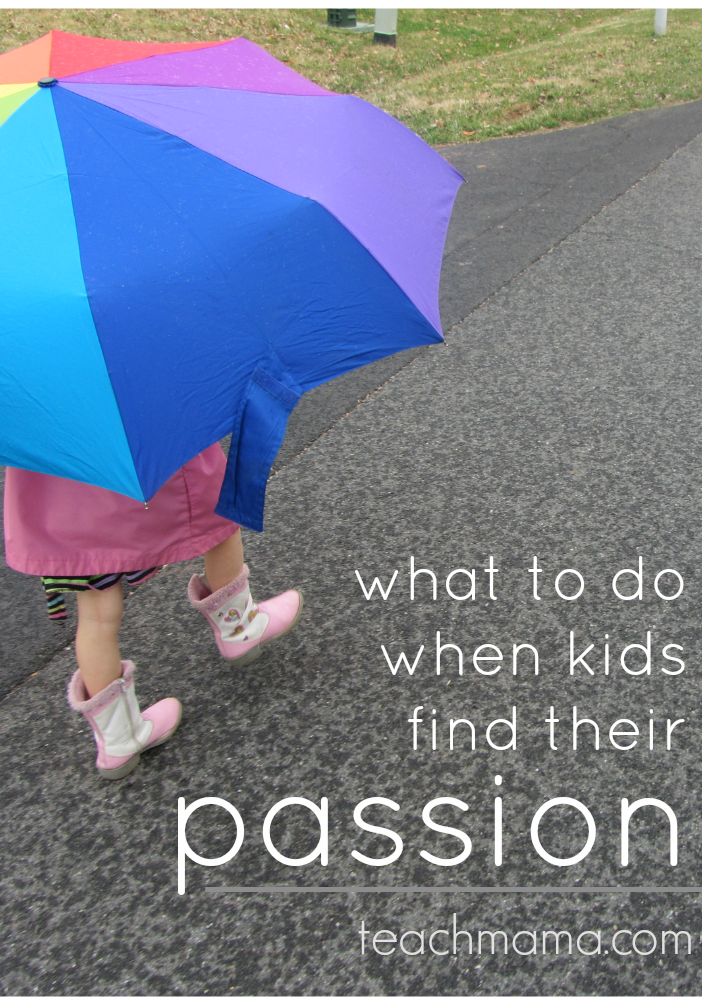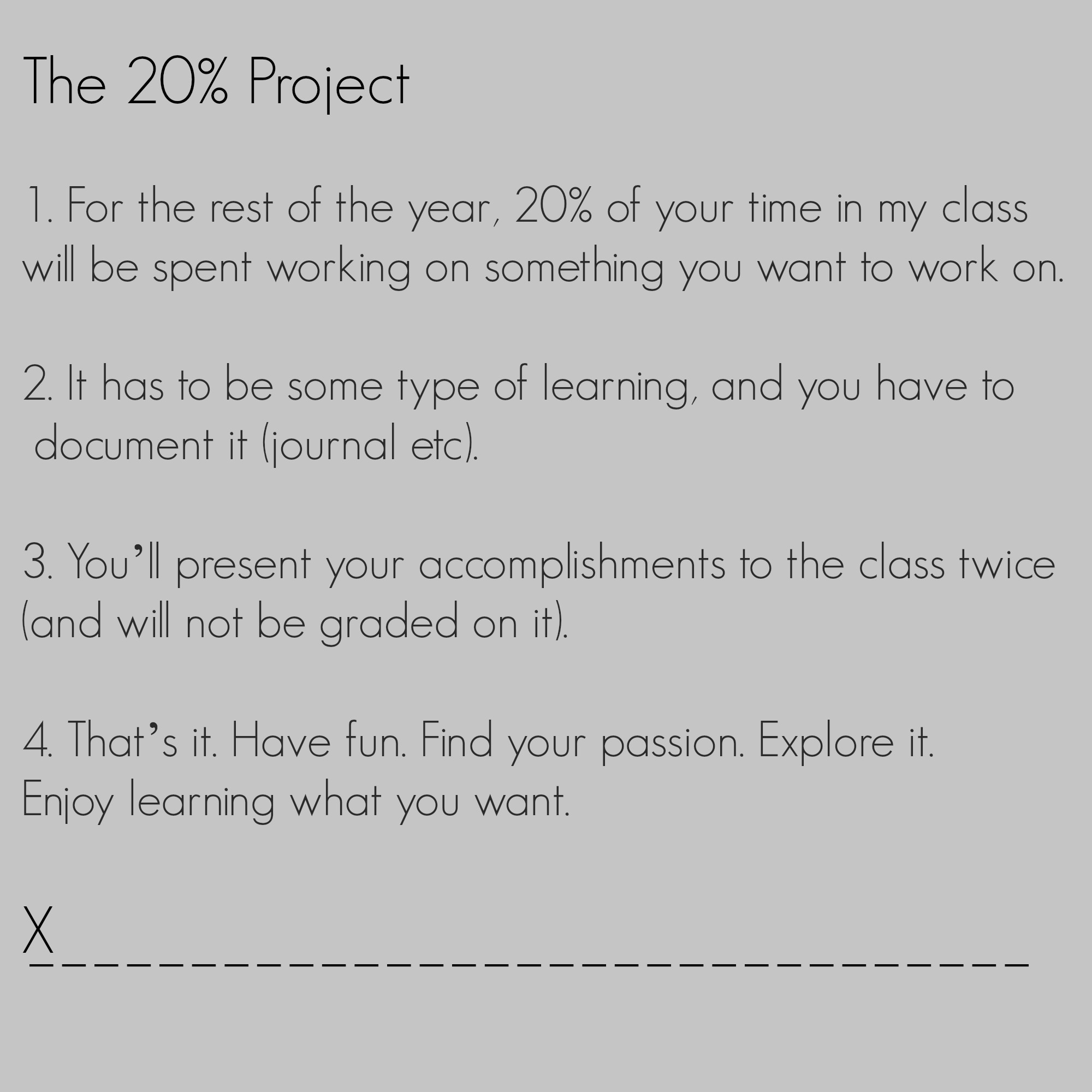The following guest post is written by A.J. Juliani, an author, teacher, and ‘learning addict’. A.J. is a K-12 Technology Educator who believes in #20time and #geniushour. He’s a father and blogger, and you need to check him out.
He’s even thrown in a rockstar freebie for you. (He seriously rocks.)
——————————
- What to do when your kids find their “passion”, by A.J. Juliani
My daughter had been singing for almost two hours with no break. The song “Do You Want to Build a Snowman” from the Frozen soundtrack was on repeat, and my wife and I looked at each other.
“She’s pretty good,” we both said as she added a new piece of choreography to her accompanying dance.
In fact, my mind started running about how good she really was, and how great she could become. We all want the best for our own kids and our students. In my daughter’s case we made sure she had a variety of experiences trying new things. From tee-ball and soccer, to swimming and gymnastics, my wife and I watched and supported her along the way.
But this was different. We always knew she liked singing and dancing, but now it had taken on a whole different level. I wondered if my daughter had found her first “passion”.
Chances are you’ve been in this same spot as a parent or teacher. We give our kids a lot of opportunities and when they finally find one they enjoy, we are excited by the possibilities. Sometimes parents and teachers may try to guide a child down a certain path of sports, or music, or learning based on their interests…but usually we wait for that spark of passion to come, and when it does the big question is: What next?
As a high school English teacher I was able to answer this question of “What Next?” when I ran a “20% Project” with my students three years ago. The project was simple. It is based on the “20 percent time” Google employees have to work on something other than their job description. It has been well documented, and Google has exponentially grown as a company while giving this 20 percent time.
After we came back from winter break I gave them this handout:
The 20% Project*
1. For the rest of the year, 20% of your time in my class will be spent working on something you want to work on.
2. It has to be some type of learning, and you have to document it (journal etc).
3. You’ll present your accomplishments to the class twice (and will not be graded on it).
4. That’s it. Have fun. Find your passion. Explore it. Enjoy learning what you want.
X___________________________________________
Mass confusion set in. Most of my students were trying to figure out what the catch was, asking questions like: “So what are we getting credit for?”, “What kinds of things can we do?”, “Why aren’t we being graded?”, and “I don’t get it Mr. J, what are we supposed to be doing?”
After a few minutes more of explanation my students began to come around. I was not going to grade them on this project, but I was going to keep them accountable. Many times in education we believe the only way to hold students accountable is by giving some form of assessment. But for this project the assessment was in the process. It was how they learned with passion, and learned because it was their choice.
As I watched my daughter sing I thought about the ways my students dealt with finding and acting on their passions. Some students had a difficult time figuring out what they were really passionate about. Others jumped right in to learn something new. While many of my students struggled with figuring out what to actually do with their time. For each student I had to figure out how to best guide and help them through this process, there wasn’t one fix that would help all of them.
However, there are three important steps that I had each of my students do during our project that helped both them and me answer the question of “What’s next?”
First, my student had to make sure they were truly passionate about what they wanted to learn. In order to differentiate between hobbies, interests, and passions I had them create a “March Madness” bracket and go through a process of elimination. When they pitted their interests against each other, it became clear to them which was really a passion that they could do all day if they were allowed to.
For younger students, I might have them use this PinterestPowerPointTemplate I made to put their interests together and go through a smaller process of elimination. This visual is also a big help regardless of the age.
Second, we had to create clear steps of what they were going to do to learn more and get better at their passion. If they wanted to play the guitar they’d first learn how to string it and play a chord before jumping into learning a song. This process showed them what growth would look like each time they came back to the project.
Third, they would have to find a mentor or guide to help them get to the next level. Often this could come in the form of a book, a YouTube video tutorial, or even a real person. But they would need guidance to continue the growth steps.
The final piece of this was putting it all together and presenting to their peers. While this can be scary, it is also needed. You can’t hide your passion from the world, we need to see it!
I knew with my daughter that three things were true:
1. She thoroughly enjoys singing, and could do it all day if she was allowed to!
2. She wants to get better. Always trying to learn a new song and perfect her rendition.
3. She was going to need help and guidance to get to the next level.
My wife and I enjoy singing but we aren’t going to be able to help her get to the next level. In this case we’ve started looking at lessons and new opportunities to let her grow. I know that I want this always to be my daughter’s choice, because as soon as we begin making decisions to force her down a path, that’s when our kids pull away and begin to lose the initial spark and passion we always want for them.
When your kids find their passion, or begin exploring new interests, make sure you give them choice before giving them guidance. Their instrinsic motivation is what is truly important, and if we can help them do what they love, then learning won’t be a chore. It will be fun and exciting…like it is supposed to be.
Looking for more 20% Time and Passion Learner information?
Visit AJ’s blog at AJJULIANI.COM. AJ is a K-12 Technology Staff Developer, and author of two books: “Teach Above The Test” and the upcoming “Inquiry and Innovation in the Classroom”. He is also the founder of Education Is My Life and the new digital magazine for educators, “The Best and Next in Education”.
Connect with AJ: Twitter/ Blog/ Google+
Get My Free eBook
Stop by and follow these great educational Pinterest boards:
- Afterschool for Smarty Pants Blog | Natalie, After School for Smart Pants
- Resources for Gifted Children | Natalie, After School for Smart Pants
- Science | Natalie, After School for Smart Pants
- Math | Natalie, After School for Smart Pants
- digital literacy | teachmama
- cool & creative indoor fun | teachmama
This post is part of our new Rockstar Sunday posts. Each week, I will highlight one ‘rockstar’ in the parenting and education field. These posts? Seriously awesome.
Have something you’d like to share that in some way relates to fun learning, school, technology, education, or parenting? For a short time we’ll be accepting Rockstar Sunday guest posts.

other posts in the series:
- 8 ways of supporting advanced learners
- tons more to come!
Having been in the blogging space for 5+ years, we know for sure that our readers are always up for fresh and fun ideas on literacy, math, technology, parenting, and learning in the every day. They love crafts, hands-on teaching ideas, printables, cooking with kids, and anything that makes their job as parents easier, better, and more fun.
You don’t have to have a blog of your own–just cool ideas to share! We look forward to hearing from you!


Just think how education would change is throughout high school students could spend 20% of their time learning about and developing their passion…Thanks for providing a great idea.
Yes Joann I think you are so right. In fact there is a growing group of teachers who think just like that and are running Genius Hour and 20% projects in their classrooms.
Like the 3 steps. Thanks!
Love this idea of having education support a child’s passion. Will make all the difference to keep kids excited about school!